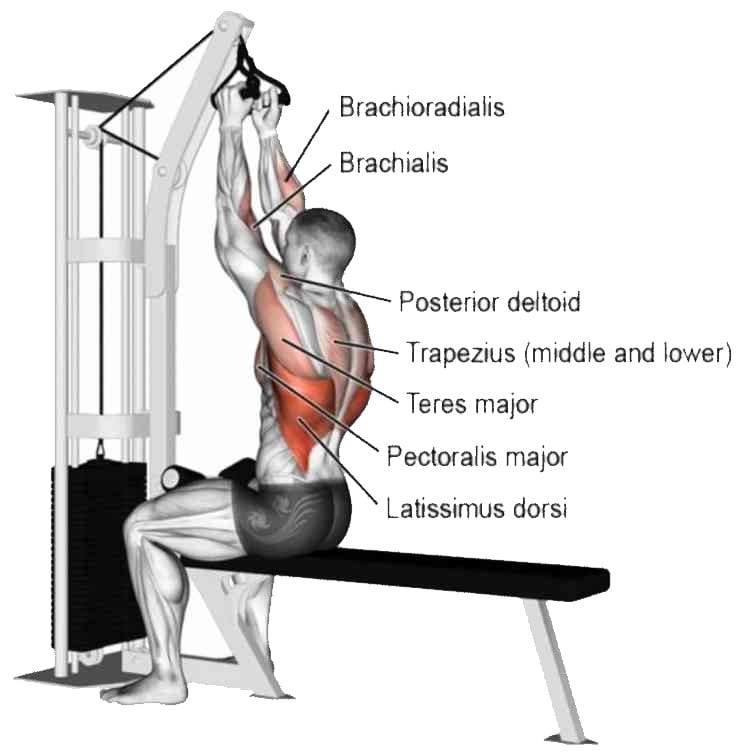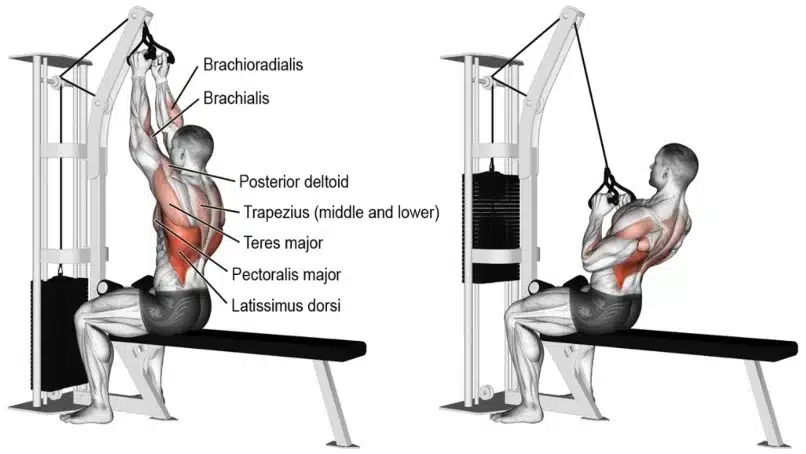If you’re looking to strengthen your back muscles, the V Bar Lat Pulldown is a great exercise to add to your back workout routine.
The V-bar lat pulldown is a compound exercise that targets the latissimus dorsi muscles. Bodybuilders and powerlifters often use it to build strength and muscle mass in the back.
We’re going to talk about how to do a v-bar lat pulldown with good form and technique, and what muscles worked doing this. The benefits and alternatives to the V Bar Lat Pulldown will also be discussed.

- What Is V-bar Lat Pulldown
- V Bar Lat Pulldown Muscles Worked
- How To Do Lat Pulldown With V Bar
- Recommended Sets and Reps
- V-Bar Lat Pulldown Form And Technique
- 1. Back Slightly Lean
- 2. Controlled Motion
- 3. Do Full Range Of Motion
- 4. Keep Your Elbow Close
- 5. Pull The Elbow Behind The Back
- 6. Focus On Breathing
- Benefits of Doing V-bar Lat Pulldowns
- V-Bar Lat Pulldown Vs Wide-Grip Lat Pulldown
- 1. V-Bar Lat Pulldown
- 2. Wide-Grip Lat Pulldown
- Which One Should You Choose?
- V Bar Lat Pulldown Alternates
- 1. Seated Cable Rows
- 2. Pull-Ups
- 3. Bent Over Rows
- 4. Straight Arm Lat Pulldown
- Conclusion
What Is V-bar Lat Pulldown
The V-bar Lat Pulldown is a variation of the Lat Pulldown exercise that targets the muscles of the back. In a standard lat pulldown, you use a wide grip on a straight horizontal bar. The V-shaped bar attachment allows you to use a close, neutral grip.
It is designed to target the muscles in your back, specifically the latissimus dorsi. This exercise also engages other muscles, such as your biceps, rhomboids, and lower trapezius. It helps you build a stronger, more balanced upper body.
It is a good exercise for building back strength and improving posture. The workout is suitable for both beginners and advanced gym-goers who are looking to diversify their back workout.
V Bar Lat Pulldown Muscles Worked
The V-bar lat pulldown is a compound exercise that works multiple muscle groups at the same time.
The V Bar Lat Pulldown focuses primarily on the muscles of the back, specifically the latissimus dorsi.
This exercise also hits your biceps and rhomboids. Your grip strength gets better too. Other parts that get a workout are your middle and lower traps. Even smaller parts like brachialis and brachioradialis don’t get left out.

How To Do Lat Pulldown With V Bar
- Attach the V-bar to the cable pulley on the lat pulldown machine.
- Adjust the thigh pads on the lat pulldown machine to make sure your legs are securely restrained.
- Sit down and grasp the V-bar with a neutral grip (palms facing each other).
- Keep your core engaged, chest up, and shoulders back.
- Keep your arms close to your body and pull the bar down toward your upper chest.
- Concentrate on squeezing your shoulder blades together as the V-bar gets closer to your chest.
- Pause at the bottom of the movement, then slowly return to the starting position.

Recommended Sets and Reps
- Beginners: 3 sets of 10-12 reps
- Intermediate: 4 sets of 8-10 reps
- Advanced: 5 sets of 6-8 reps
V-Bar Lat Pulldown Form And Technique
Even though the v bar lat pulldown exercise is very popular, many people make common mistakes when they do it. Here are some of the things you should avoid:
1. Back Slightly Lean
Excessively leaning back can disengage the latissimus dorsi and put unnecessary strain on your lower back. Maintain an upright posture, leaning slightly back, just enough to prevent the bar from hitting your face.
2. Controlled Motion
Using body momentum to jerk the weight down reduces the effectiveness of the exercise and increases the risk of getting hurt. Use a controlled, steady movement, both while pulling the bar down and releasing it back up.
3. Do Full Range Of Motion
Make sure you fully extend your arms at the starting position and pull the bar down at the upper chest level. Additionally, focus on squeezing the shoulder blades together at the bottom of the movement.
4. Keep Your Elbow Close
Flaring the elbows too far out or dragging them too far back can reduce lat engagement and put stress on the shoulders.
You should keep your elbows pointing downward and to the rear during the movement.
5. Pull The Elbow Behind The Back
Focus on pulling your elbows to your sides and behind your back, rather than cranking your arms closed. Studies show that this cue will help you to increase lat activation.
6. Focus On Breathing
Take a deep breath in as you extend your arms to the starting position. Breathe out as you pull the bar down to your chest. Breathe in again as you release the bar to the starting position.
Benefits of Doing V-bar Lat Pulldowns
- The neutral grip can be easier on the wrists and shoulders.
- It’s a compound exercise that works multiple muscle groups.
- Strengthens the biceps and forearms as secondary movers.
- It helps to build a V-shaped torso.
- Easily integrated into various workout routines for strength, hypertrophy, or endurance goals.
V-Bar Lat Pulldown Vs Wide-Grip Lat Pulldown
The V-Bar Lat Pulldown and the Wide-Grip Lat Pulldown are both effective exercises for targeting the back, but they do so in slightly different ways. Here’s a quick comparison:
1. V-Bar Lat Pulldown
- Grip: Utilizes a close, neutral grip on a V-shaped bar.
- Muscle Focus: Targets the lower part of the lats more directly.
- Secondary Muscles: Engages more of the biceps and lower traps.
- Joint Stress: Generally neutral grip is easier on the shoulders and wrists.
- Range of Motion: Typically allows for a more extended range of motion in the downward phase.
2. Wide-Grip Lat Pulldown
- Grip: Uses a wide overhand grip on a straight bar.
- Muscle Focus: Targets the upper part of the lats and broadens the back.
- Secondary Muscles: Engages the teres major and rhomboids more significantly.
- Joint Stress: May be stressful for individuals with shoulder issues.
- Range of Motion: The wide grip may limit the range of motion during the exercise.
Which One Should You Choose?
- V-Bar for Lower Lats: Choose the V-bar variation if you wish to target the lower lat muscles and prefer a movement that is easier on the joints.
- Wide-Grip for Upper Lats: Opt for the wide-grip if your goal is to build a broader back and you have no shoulder discomfort.
V Bar Lat Pulldown Alternates
1. Seated Cable Rows
The cable row is an effective exercise for building your back muscles and increasing overall upper body strength. It is a compound exercise that works multiple muscle groups.
It focuses mainly on the lats and helps improve posture, with an easier weight adjustment than barbell exercises.
2. Pull-Ups
Pull-ups are a great alternative to the v-bar lat pulldown exercise, as they work the same muscle groups and offer a similar range of motion
3. Bent Over Rows
This exercise targets the upper back muscles and can be a good alternative to V-bar Lat Pulldowns. It can be performed with a barbell or dumbbells.
Bent-over rows are a free weight exercise that works the latissimus dorsi muscles, as well as the rhomboids, teres major muscles, and biceps brachii muscles
4. Straight Arm Lat Pulldown
This exercise targets the lats and can be a good alternative to V-bar Lat Pulldowns2. It is performed with a straight bar attached to a cable machine.
Conclusion
The V bar lat pulldown is a great exercise for strengthening your back and improving core and shoulder stability. If you follow the guide step-by-step, you can make sure your form is correct and get the best results.
Don’t forget to avoid common mistakes and try out different variations to keep challenging yourself. It is recommended to add this exercise to your upper body workout routine to strengthen your back.
References
- Andersen, V., Fimland, M. S., Wiik, E., Skoglund, A., & Saeterbakken, A. H. (2014). Effects of grip width on muscle strength and activation in the lat pull-down. Journal of Strength and Conditioning Research, 28(4), 1135-1142. doi:10.1097/JSC.0000000000000232
- Lusk, S. J., Hale, B. D., & Russell, D. M. (2010). Grip width and forearm orientation effects on muscle activity during the lat pull-down. Journal of Strength and Conditioning Research, 24(7), 1895-1900.

Manish brings over 10 years of hands-on experience in weight lifting and fat loss to fitness coaching. He specializes in gym-based training and has a lot of knowledge about exercise, lifting technique, biomechanics, and more.
Through “Fit Life Regime,” he generously shares the insights he’s gained over a decade in the field. His goal is to equip others with the knowledge to start their own fitness journey.
